Step-by-step instructions for beginners: how to grow mushrooms at home
The idea of growing champignon mushrooms at home, as practice shows, turns out to be a rather successful enterprise. After all, this is not only a way to get a valuable and nutritious product, but also an opportunity to organize your own small business with minimal investment.
True, not everyone succeeds in doing it right the first time, just in the cultivation of champignons, each master has his own secret, which is not revealed immediately.
Although in fact it is quite possible to grow champignons even in a city apartment, the technology for carrying out the work is so simple and accessible.
What conditions are necessary for growing mushrooms
A regular basement can be an ideal place to grow mushrooms. It is a basement with a concrete floor, a large air volume and a constant temperature. Ideally, the conditions of the room should be as close as possible to the natural conditions for growing mushrooms.
The classical technology of mushroom cultivation provides for a number of important points, which cannot be ignored:
-
Preparation of a nutrient medium for growing a substrate;
-
Isolated room for breeding mycelium;
-
Maintaining sterile cleanliness;
-
Strict control of air humidity, temperature;
-
Effective room ventilation system.
Unlike growing seedlings or green onions for mushroom production, it is not necessary to have special, as, indeed, ordinary bright lighting, here it is enough that it is just convenient to work. Depending on the volume of the planned production, it is necessary to provide options for the placement of the working space - racks, a suspension system for bags with mycelium or placement in boxes on the floor. This is important because you have to work with a large area of compost bins.
The room must be kept sterile - the mushroom mycelium is a very delicate thing, like any other organism it is susceptible to disease, there is a favorable and dangerous environment for it. That is why, before starting work in the basement, it is necessary at least to remove all preservation, disinfect the floor, walls and ceiling, and install thin metal mesh grilles on the ventilation openings.
The life cycle of the mycelium goes through several stages, from the beginning of development to the finished fruit, while for the most effective growth, it is necessary to strictly control the humidity of the air and its temperature. In view of this, the cellar must be equipped with a hydrometer, thermometer and psychrometer. Over time, when experience appears, the list of control devices will be expanded - it will be necessary to purchase devices for monitoring CO2, thermometers for measuring the temperature of the compost.
Basement must have a well-functioning ventilation system - the inflow of fresh air and the removal of waste air must be ensured as efficiently as possible. But at the same time, the ventilation system itself must be re-equipped to work precisely in the conditions of a mini-farm for growing mushrooms.
For this, it is provided to protect the ventilation ducts from the penetration of rodents and insects, by means of heating devices for the air that enters the room.The exhaust duct should be equipped with an additional exhaust fan to quickly evacuate CO2-rich air.
And most importantly, the basement should have an additional heating system, if in an ordinary basement for storing vegetables it is enough just to maintain a temperature of + 2-3 degrees, then for growing champignons this will not be enough, here you need at least + 18-20 degrees.
What you need (raw materials, materials, tools)
The basis for growing mushrooms is prepared compost. It is the most important and most time consuming material to prepare for the job. The approximate preparation time for compost based on straw and cow dung is 3-3.5 weeks. Naturally, for preparation, you will need at least a separate outdoor area for storing and ripening compost.
To obtain a bountiful harvest with maximum return from every centimeter of the area, it is necessary to purchase ready-made mycelium of mushrooms or prepare it yourself from myceliums growing in natural conditions. Buying a ready-made mycelium is preferable in terms of the fact that the germination rate of spores in it is much higher than in the usual natural one.
Depending on the cultivation method, you will need:
-
Wooden boxes;
-
Plastic containers;
-
Plastic bags;
-
Polyethylene film;
-
Spunbon;
-
Ridge boards.
When working with compost ingredients and already matured material, you will need:
-
Shovel;
-
Pitchfork;
-
A set of tools for working with flowers - a small shovel, miniature rake, glanders;
-
Buckets with a capacity of 10 and 5 liters;
-
Gloves.
If the cultivation is planned to be done indoors, then it is worth thinking about the convenience of the workplace - to think over the system for placing the beds and the design of the equipment. These can be racks for compost boxes, a hanging system for bags, tables for placing containers or cabinets for arranging beds.
A separate line of expenses is the measuring tool. It is imperative to purchase a thermometer, hydrometer, psychrometer. To control acidity, you need to have a test strip, and to control the saturation of CO2, a device for determining carbon dioxide.
Room selection
The process of growing mycelium, preparing and ripening compost and direct commercial production of mushrooms should be divided and carried out in separate rooms. It will be extremely problematic to carry out all operations in one room - the maturation temperature of the compost at 90% humidity will reach 60 -70 degrees. At the same time, the process itself, when horse or cow manure will turn into compost, will be accompanied by the evaporation of just a huge amount of ammonia, which is detrimental to mushrooms. Therefore, it is rational to provide a separate room for growing mushrooms and an outdoor area for preparing compost.
Industrial production in the amount of several hundred kilograms per day or a small mini-farm for growing a small volume - 100-250 kg of mushrooms per month should provide a consistently comfortable temperature for mushroom growth. Considering that mushrooms are very susceptible to temperature changes, then a relatively small, well-insulated room equipped with a ventilation unit will allow avoiding daily temperature fluctuations.
It is best to use a basement or a separate cellar for this. This is the only room that can be converted at low cost into a mushroom minifarm.
Preparation
The initial stage of preparing a basement for a minifarm should be the laying of new communications and ventilation systems. Ventilation in the basement is installed as a conventional supply with natural air circulation, and forced with the installation of an exhaust fan.Indoor ventilation pipes are laid along the entire length of the room to ensure effective intake of exhaust air from all areas of the basement.
The outlet is equipped with additional deflectors to increase the exhaust air flow. When laying air duct pipes for the supply hose, a filter is provided to clean the air from dust and insects. If the room has high humidity, it is necessary to equip an additional dehumidifier to prepare the supplied air.
Working with mushroom mycelium provides for constant moistening of the compost and the soil layer, while it is important that moisture is retained in the compost. Therefore, when preparing a room, you need to pay attention to the condition of the walls, ceiling and floor. The ground floor, in the room must be replaced with concrete, the wooden floor beams must be covered with a layer of waterproofing and, if possible, made insulation with a strong hydrophobic surface.
Disinfection
Growing mushrooms requires constant cleanliness in the room. Preventive disinfection is carried out:
-
Deep disinfection of all surfaces after the completion of preparatory work;
-
Before placing the compost boxes for the mycelium application;
-
After the end of the cycle of growing mushrooms and harvesting waste material.
After the completion of construction work, it is necessary to whitewash the room with a lime mortar. After that, it is recommended to provide disinfection with formalin solution and treatment with ultraviolet radiation.
During the compost change period, it is recommended to clean it with a disinfectant solution and re-quartzate.
Zoning
If the room permits, it is recommended to divide it into several zones. Zoning will ensure the effective use of the basement area and create the necessary conditions for the growth of mushrooms. In the zoning plan, it is recommended to create:
-
Mycelium preparation area;
-
A zone for growing commercial mushrooms;
-
Storage area for finished products;
-
Working area.
The division into zones does not have to be done from capital walls, it is enough to make partitions from strips of strong plastic film.
Planting mycelium
At first, while there are no skills to independently grow mycelium from the available substrate, it is recommended to use ready-made spores of mushrooms sold in stores. The best option is to buy disputes directly from the manufacturer, in this case the germination rate will reach 70-80%.
Mycelium is grown from the spore material, this is a mandatory procedure if there is a desire to grow mushrooms in large volumes. For home cultivation, the grain and compost method of cultivation is recommended.
For growing by the grain method it is necessary:
- 10 kg of wheat or rye;
-
Capacity with a volume of 20-25 liters;
- 8-10 liter jars with lids;
The technology for preparing mycelium is as follows - the grain is poured with 15 liters of water, brought to a boil and then simmered over low heat for 1.5-2 hours. The grain should not be cooked, but it should be soft.
After the grain has reached the condition, the water is drained and the grain is dried. At the same time, the jars are disinfected, the cooled grain is laid out on the jars evenly and covered with lids. Holes must be made in the covers for air circulation. After the grain has cooled to +24 degrees, mushroom spores are placed in the jars. The holes are closed with cotton swabs. The readiness of the mycelium is determined visually when it occupies the entire volume of the jar of grain.
The compost method does not differ from the grain method, the only difference is that instead of liter cans, 3-liter cylinders are used, and the grain is replaced with compost. True, it fits into already sterilized jars and heats up directly there.
Transfer of mycelium to the nutrient medium
After the mycelium is ripe, it is transferred to trays, containers, boxes or bags with prepared compost.The compost is disinfected before adding the mycelium and the trays are set in place. There are no norms for distributing mycelium in containers, but usually a liter jar is used for 30-40 kg of compost.
Choosing a variety of champignons
In the modern mushroom business of the company, manufacturers of material for growing mycelium can offer about 300 varieties and types of mushrooms. But it just so happened that the most popular are champignons and oyster mushrooms.
For home breeding, it is recommended to use mushroom varieties and strains industrially grown in specialized farms. Recommended for cultivation in minifarm conditions include:
-
Samuel 512 is a highly productive French variety. Possesses high germination and long-term fruiting. Unpretentious to the conditions of detention - especially the temperature regime. Possesses excellent taste.
-
Salvan 130 is a hybrid with high germination and a long fruiting period. Productivity and commercial qualities largely depend on the correct maintenance of the temperature regime. Requires constant monitoring of indoor humidity and temperature. It has a high immunity to most diseases. Possesses good taste.
-
U-3 is an early-ripening variety of champignons with the first wave of commercial mushrooms 20-24 days after planting the mycelium. Demanding temperature and ventilation. If the technology is violated and the cultivation regime is not followed, the mushrooms can be small. Possesses excellent taste. Proportional structure, with a high density of the cap body.
-
273 is a hybrid with a distinctive "royal" brown hat. Perfectly adapts to growing conditions, not particularly picky about strict adherence to temperature conditions. A high-yielding variety capable of producing up to 20 kg of fruit per square meter of plantation.
These hybrids are widely available on the market both as a material for the cultivation of mycelium, and in the form of ready-made compost compositions for self-cultivation.
How to plant mycelium correctly
After the mycelium is ready, it is transplanted into prepared boxes or bags. This is done in a checkerboard pattern, with a distance of 15-20 cm from each other. The mycelium is buried in the compost by 4-5 cm. After planting, the bags are covered with a cloth and regularly moistened with warm water - the temperature for irrigation is 15-20 degrees.
The main growth of mycelium occurs in the first 5-7 days. Humidity during this period is maintained at 80-95%. The temperature regime should be as even as possible, without fluctuations - the optimum temperature is 22-25 degrees. A higher temperature should not be maintained. On days 10-12, the surface is covered with a soil mixture of 5 parts of peat, 4 parts of soil and 1 part of limestone. Moistening is done at least 2 times a day, avoiding drafts and drying out of the soil cushion.
On the 5-6th day after that, the temperature is lowered to 13-15 degrees, this is necessary for the start of mushroom sprouting after the temperature rises to 22-24 degrees.
Further care
After the temperature drops to 13-15 degrees, the main care will consist in observing the temperature regime, constant ventilation of the room (at least 2 times a day) and moistening the bags with mushrooms.
As the mycelium grows, moisture increases and the temperature rises to 17-20 degrees. After the start of active growth, it is recommended to maintain a stable temperature and monitor the CO2 level in the room.
Features of growing mushrooms in bags
For cultivation, polyethylene bags made of dense material with a height of 0.7-1.0 meters are used. After filling the bag with compost and planting the mycelium, the bags are placed on pallets so that it is convenient to work. After the appearance of mushrooms on the surface, top dressing is made from 1 part of chalk and 4 parts of peat. Application rate 60-100 grams per 1 sq. meter. If rot or other diseases are detected, the bag is removed from the room.
After the end of the fruiting process of the mycelium, the compost is removed, and the bags, after disinfection with a formalin solution, can be reused.
Harvesting
The first mass harvesting is usually done 21-24 days after the mycelium is added to the compost. Re-collection is usually 75-80% of the original volume. The final fee is usually up to 50% of the first fee. After that, the yield drops sharply.
The collection of mushrooms is carried out with a knife - the mushrooms are cut at the root, while it is advisable not to damage the mycelium. Ready-made mushrooms are ready for further processing and conservation.
For those who have set themselves the goal of cultivating champignons at home, knowing the technology and consistently performing all the operations, it is not difficult to do this. The main thing is to set a goal for yourself and systematically adhere to the timing of all events. Even beginners, in the modest conditions of a small basement or balcony, manage to grow a decent harvest of mushrooms.
Watch the related video:



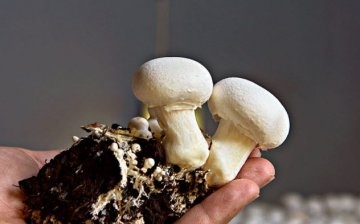
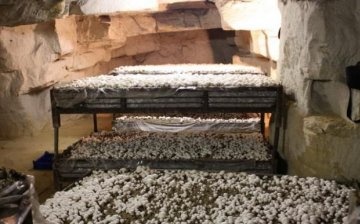
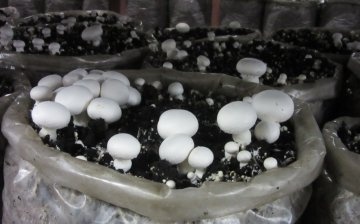



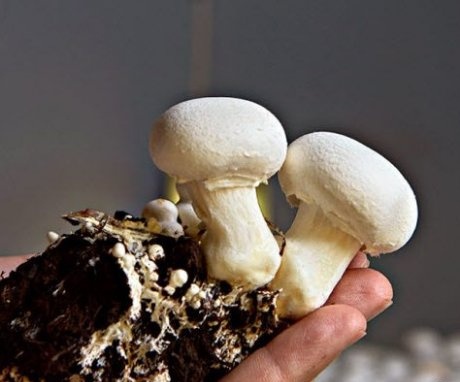
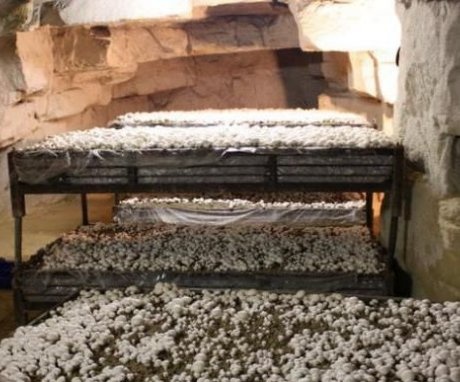
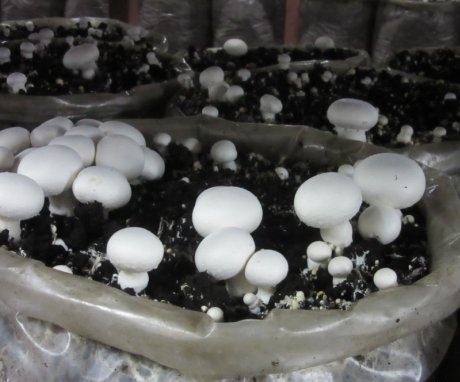
At the very beginning of the article, 5 conditions for growing mushrooms are written and many of them are difficult to fulfill. For example, efficient ventilation and maintain humidity and temperature in the basement. Therefore, a supply and exhaust ventilation system with irrigation chambers is definitely needed, but this is difficult and expensive. It is much easier to grow oyster mushrooms.